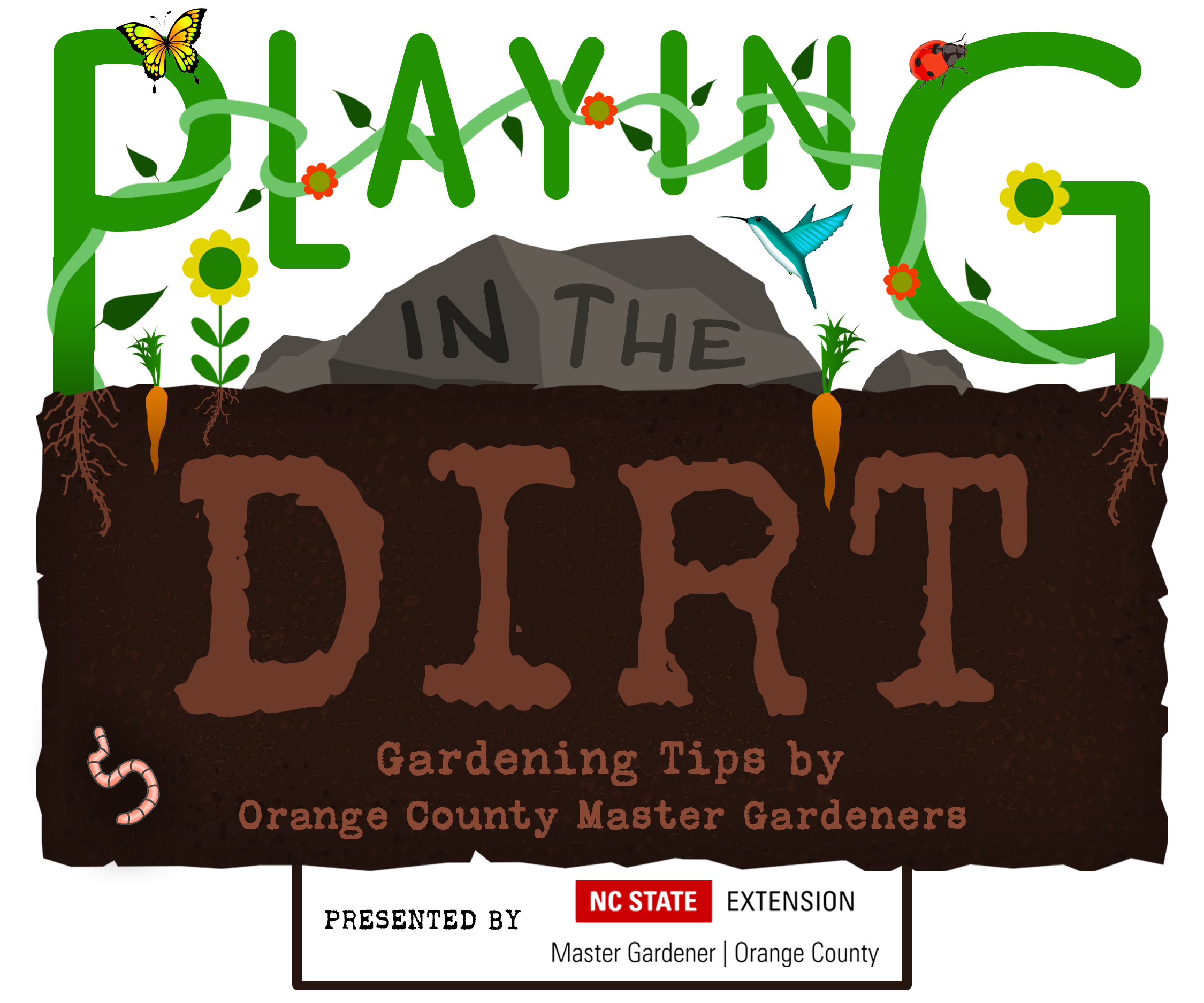
97.9 The Hill and Chapelboro.com have partnered with NC State Extension Master Gardener℠ volunteers of Orange County for “Playing in the Dirt,” a monthly column providing information and inspiration to gardeners of all skill levels! Check back on Chapelboro each month for a new subject – from our gardens to yours!
By Lynn Calder, Orange County Master Gardener℠ volunteer
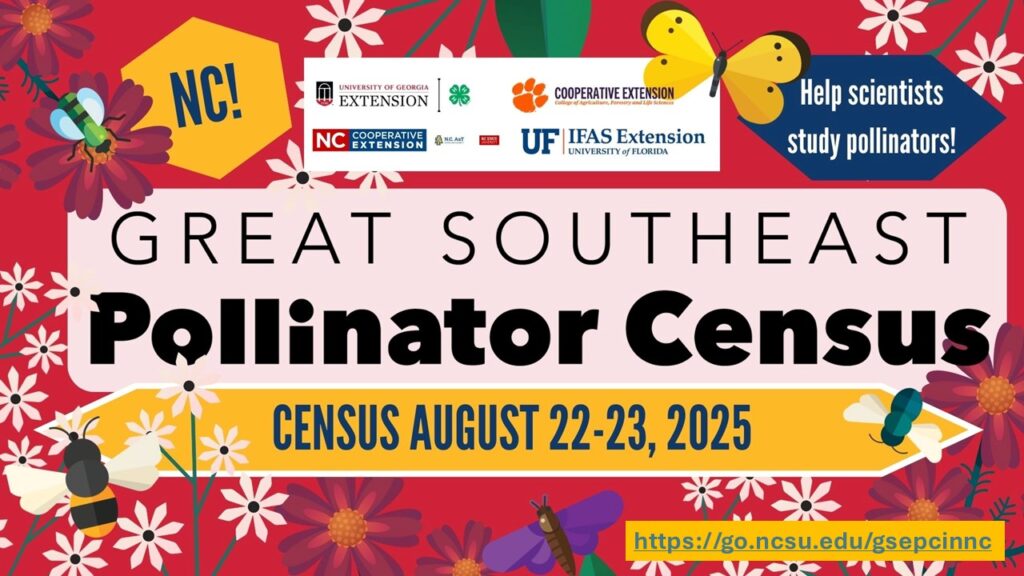
Due to weather forecasts in the Southeast for Friday and Saturday, Sunday, August 24th has been added as a count date.
The Great Southeast Pollinator Census was founded by the University of Georgia Extension in 2017 and has grown into a community science project taking place across five states including North Carolina. The goal is for “citizen scientists” (anyone in the community – no expert knowledge needed!) to take data over two days in August (three days this year!) to capture a snapshot of pollinators. You only need to spend 15 minutes observing a plant and collecting information about insects that visit the plant.
Find all the details, including an insect counting guide, insect identifier with photos, instructions for submitting your findings and all kinds of other ideas for pollinator-count activities for kids and adults right HERE.
Here are some handy quick links to help you count Friday, Saturday and Sunday, August 22-25, and report your findings beginning August 22:
- Insect Counting and ID Guide and Pamphlet both with color photos to help identify the insects you see.
- Printable Counting Sheet.
- The portal for reporting counts will open on August 22 – see the GSEPC website.
This is a fun — and important — project for one pollinator-curious person or for inviting a group to celebrate and count butterflies, bees, moths, flies, wasps, beetles, dragonflies, lacewings, and other insects.
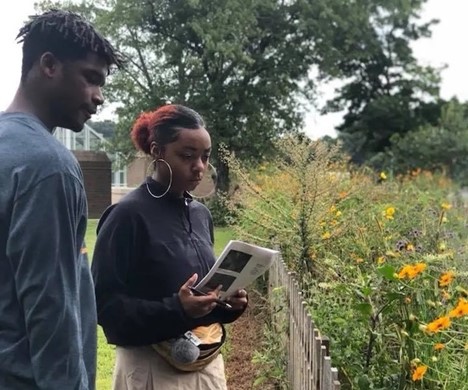
Students from Maynard Jackson High School in Atlanta counted insects during the first pollinator count in 2019. Photo courtesy of University of Georgia Extension.
Late-Season Blooms That Attract Lots of Pollinators
To find insects for your pollinator count, you could look for some of these late-summer and early-fall blooming natives and non-natives that provide essential nectar when many plants have finished blooming. The nectar helps fuel migrating pollinators for travel and nourish over-wintering insects to thrive during the colder months when food is scarce. Consider picking up a packet of wildflower seeds specialized for the Southeast to plant this fall so that your garden provides this nourishment in late summer and fall next year. And think of the color and beauty you’ll enjoy too!
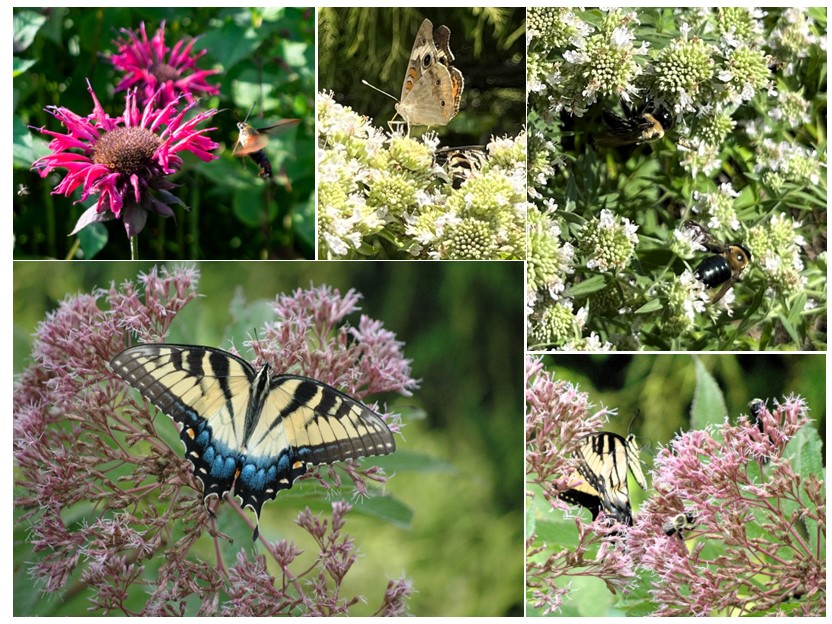
Commonly found late-blooming native plants and pollinators in our area: (l-r) hummingbird moth, or sphinx moth, on beebalm (Monarda – several native species of Monarda attract bees, butterflies, moths and many other insects); common buckeye butterfly on mountain mint (Pycnanthemum); bees extracting nectar from mountain mint; bees and yellow swallowtail on Joe-pye-weed (Eutrochium); yellow swallowtail on Joe-pye weed. Photos by Lynn Calder.
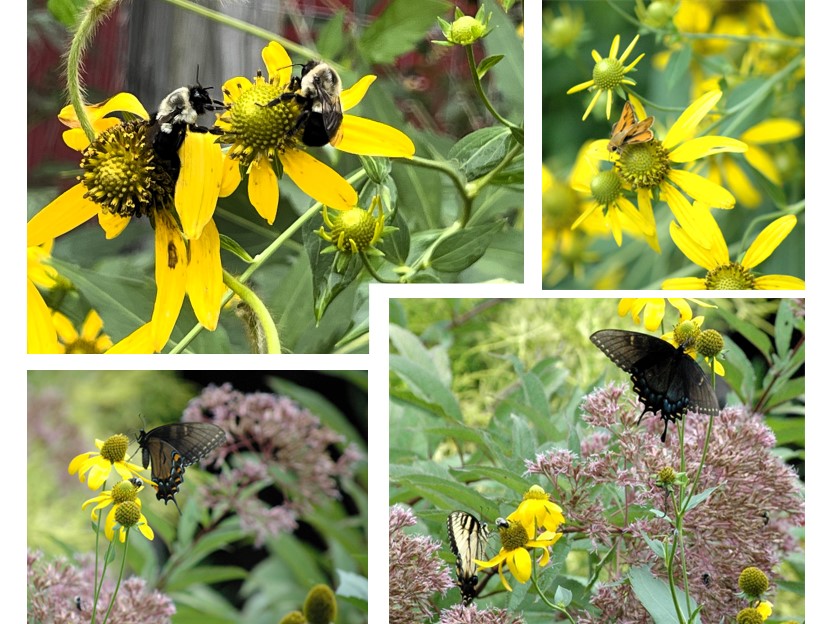
Cutleaf, or green-headed, coneflowers (Rudbeckia laciniata), another late-season native that attracts many pollinators: (l-r) bees sharing a cutleaf coneflower blossom; fiery skipper butterfly (hylephila phyleus) on coneflower; Eastern tiger swallowtails and bees on coneflower; female Eastern tiger swallowtail and bee. Photos by Lynn Calder.

Non-native plants can provide nectar and pollen for some native pollinators though the insects prefer native species. For example: (l-r) bees are attracted to the succulent known as live-forever or stonecrop (Hylotelephium spectabile, formerly included in genus, Sedum) and to hardy chrysanthemums (Chrysanthemum Rubellum Group); Eastern tiger swallowtail visits common lantana (Lantana camara). Photos by Lynn Calder.

More native flowers where pollinators may be found in August: (l-r) bumble bee and black swallowtail on field thistle (Cirsium discolor, not to be confused with the aggressive European bull thistle); in this garden, obedient plant, brown-eyed Susan, blue vervain and rattlesnake master all attract pollinators; katydid wasp on yellow passionflower vine; spicebush swallowtail on ‘Jeana’ garden phlox. Photos by Debbie Roos, Chatham County Extension, from the Chatham Mills “Pollinator Paradise” Garden she maintains.
Fall Gardening Tips for Your Pollinator Garden
Good Tasks to Do!
- Fall (especially October or early November) is a great time to divide perennials that have become overgrown or overcrowded — the soil is still warm enough for roots to start getting established before winter. Expand your garden elsewhere or pass along the extras to neighbors! Be sure the new transplants are watered deeply once a week through rain or irrigation.
- Tag dormant perennials that are hard to identify in winter so you know what to expect in spring.
- Sow seeds for native species in late fall. You can find commercial seed packets specially mixed to grow well in the Southeast or try planting saved seeds from your own or a friend’s garden. The seeds will germinate over winter and sprout in spring. See Grow Wildflowers!
- Stay on top of your weeding so you aren’t overwhelmed in spring! See Nip Weeds in the Bud This Fall!

Leave the leaves and save the stems! Insects depend on them in winter: (l-r) late November black swallowtail caterpillars on their native host plant, golden alexander (swallowtails overwinter in the chrysalis stage among the leaves); black swallowtail chrysalis on coneflower stem. Photos by Debbie Roos.
Don’t do too much clean-up!
- Insects depend on your pollinator garden even when it’s not producing nectar. Small creatures use plant stems, leaf litter, brush piles, dead wood and bare ground for critical habitat throughout the winter.
- Leave the Leaves! Those fallen leaves provide so many benefits! They’re habitat and protection for small wildlife and for insects in various stages of their life cycle (including non-migratory butterflies); they’re covering for seeds, insects and other food sources for birds and small creatures; they also help retain moisture, suppress weeds, reduce erosion and enhance the soil as they decompose. While keeping in mind that a heavy leaf layer can suffocate a cool season lawn, let them stay wherever you can.
- Save the stems too! Dead stems and seedheads provide seeds for birds and shelter and nesting sites for many insects, as well as structure and interest for the winter garden. When is a good time to cut back stems? Late February and March for the earliest emerging insects in spring who will be looking for new nesting sites.
Want to Know More?
- Everything to know about the Great Southeastern Pollinator Census (NC State and Lee County Extension Fact Sheet and Guide on the Great Southeastern Pollinator Census in NC), including photographic guides to species, instructions for submitting your count, maps of area pollinator gardens, activities for kids and adults, and links to YouTube webinars:
- “Get to Know the Insects”, insect identification webinar
- “Knowledge is Pollinator Power”, pep-rally with research update on nectar resources in flowers, bee host plants and butterflies
- What’s in Bloom at the Chatham Mills “Pollinator Paradise” Demonstration Garden? Photos of garden plants and insects by year and month taken and published by Debbie Roos, Chatham County Extension.
- Fall Chores in the Pollinator Garden: Leave the Leaves and Save the Stems! Debbie Roos, Chatham County Extension.
Playing in the Dirt articles and resources:
- 12 Things You May Not Know About Honeybees, November 2022
- Helpful Tips for Fall Gardening, October 2021
- Autumn is a Busy Time for Gardeners, October 2023
More from the Master Gardener Volunteers of Orange County:
SAVE THE DATE!
PlantFest, annual plant sale and garden festival hosted by the Master Gardener volunteers of Orange County, will take place Saturday, Oct. 11, 2025, 9 a.m. to 3 p.m., at a new location: Blackwood Farm Park, 4215 NC 86 South, Chapel Hill.
Fun for all! A big plant sale with many native plants and a garden festival featuring gardening exhibits and demonstrations, kids’ activities, a nature-themed art sale, free seeds, tool sharpening, food trucks, exhibits hosted by partner organizations, music and more! Click here for updates and details.
Free gardening talks this fall!
This fall, the Master Gardener volunteers of Orange County will offer “Dig Deeper With Us,” a series of free gardening talks at the Orange County Public Library (137 West Margaret Lane, Hillsborough). Register here. Hope you can join us!
- Sunday, Sept. 14, 2-3:30 p.m.: Native plants. (Julee Herbert and Linda Bell, Master Gardener volunteers in Orange County.)
- Sunday, Oct. 19, 2-3:30 p.m.: Tick-borne diseases. (Jennifer Platt, PhD, adjunct public-health professor at UNC and co-founder of Tick-borne Conditions United (TBCU), and Onyinye Iweala, MD, PhD, a UNC physician who studies alpha-gal allergy to mammal meat.)
- Sunday, Nov. 16, 2-3:30 p.m.: Deer issues. (April Pope, North Carolina Wildlife Federation.)
Visit our booths at farmers’ markets!
- Carrboro Farmers’ Market, 8 a.m.-noon every Saturday beginning Sept. 13.
- Eno River Farmers’ Market in Hillsborough, 8 a.m.-noon the third Saturday of each month through October.
Have a plant or garden question? Email us at ocmgardeners@gmail.com or phone 919-245-2061 (leave message).
Visit our website: TheOrangeGardener.org.
Subscribe to our monthly newsletter: The Garden Buzz.
Follow us on Facebook: Our page is NC State Extension Master Gardener volunteers, Orange County.
Chapelboro.com does not charge subscription fees, and you can directly support our efforts in local journalism here. Want more of what you see on Chapelboro? Let us bring free local news and community information to you by signing up for our newsletter.

